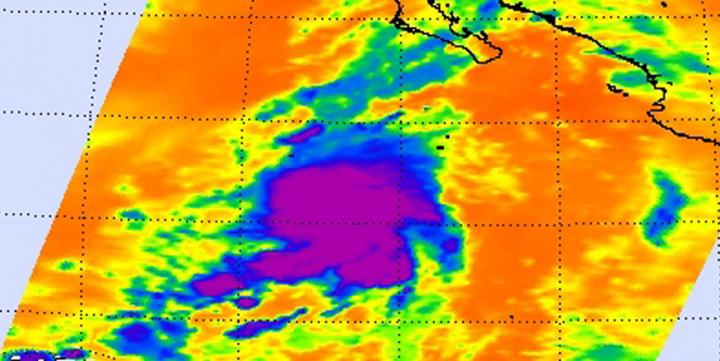NASA sees shapeless Tropical Depression 14E

This false-colored infrared image from NASA's Aqua satellite showed southwesterly vertical wind shear is pushing the thunderstorms to the northeast of Tropical Depression 14E's center on Sept. 2 at 5:05 a.m. EDT. Credits: NASA JPL, Ed Olsen
NASA's Aqua satellite passed over Tropical Depression 14E on September 2 at 0905 UTC (5:05 a.m. EDT).
The Atmospheric Infrared Sounder or AIRS instrument aboard looked at Tropical Depression 14E in infrared light and saw that strong convection (rising air that creates the thunderstorms that make up a tropical cyclone) had increased since Sept. 1, however, southwesterly vertical wind shear is pushing the thunderstorms to the northeast of the center.
At 11 a.m. EDT (1500 UTC) the center of Tropical Depression Fourteen-E was located near latitude 16.2 North and longitude 115.0 West. That's about 570 miles (915 km) southwest of the southern tip of Baja California.
The depression was moving toward the north near 9 mph (15 kph) and this general motion is expected to continue through the next couple of days.
A turn toward the north-northeast with a reduced forward speed is forecast Thursday night.
Maximum sustained winds are near 35 mph (55 kph) and the National Hurricane Center noted that the depression still could become a tropical storm later on September 2. For updated forecasts, visit: http://www.
Media Contact
All latest news from the category: Earth Sciences
Earth Sciences (also referred to as Geosciences), which deals with basic issues surrounding our planet, plays a vital role in the area of energy and raw materials supply.
Earth Sciences comprises subjects such as geology, geography, geological informatics, paleontology, mineralogy, petrography, crystallography, geophysics, geodesy, glaciology, cartography, photogrammetry, meteorology and seismology, early-warning systems, earthquake research and polar research.
Newest articles

First-of-its-kind study uses remote sensing to monitor plastic debris in rivers and lakes
Remote sensing creates a cost-effective solution to monitoring plastic pollution. A first-of-its-kind study from researchers at the University of Minnesota Twin Cities shows how remote sensing can help monitor and…

Laser-based artificial neuron mimics nerve cell functions at lightning speed
With a processing speed a billion times faster than nature, chip-based laser neuron could help advance AI tasks such as pattern recognition and sequence prediction. Researchers have developed a laser-based…

Optimising the processing of plastic waste
Just one look in the yellow bin reveals a colourful jumble of different types of plastic. However, the purer and more uniform plastic waste is, the easier it is to…



